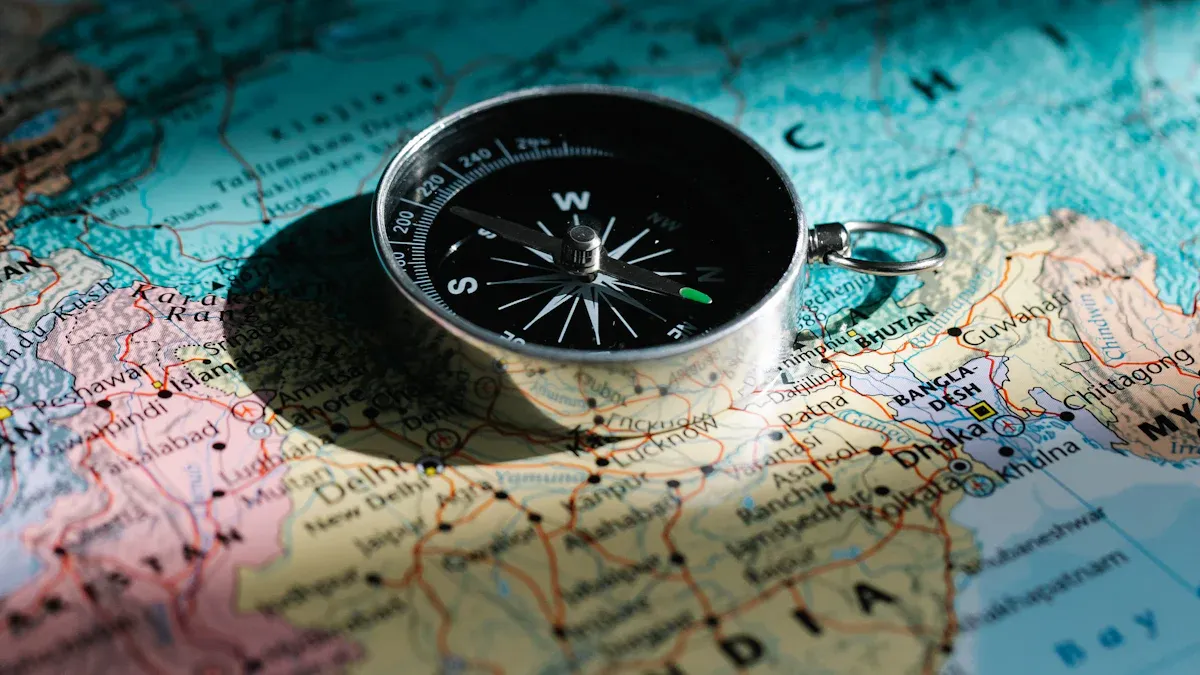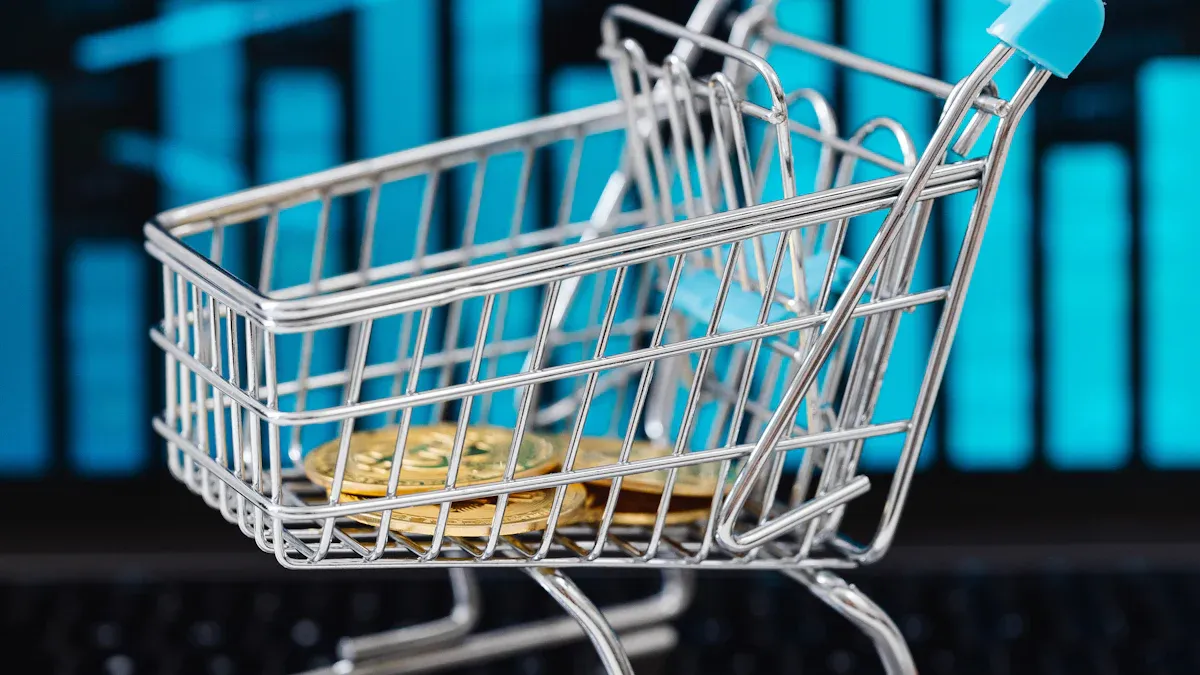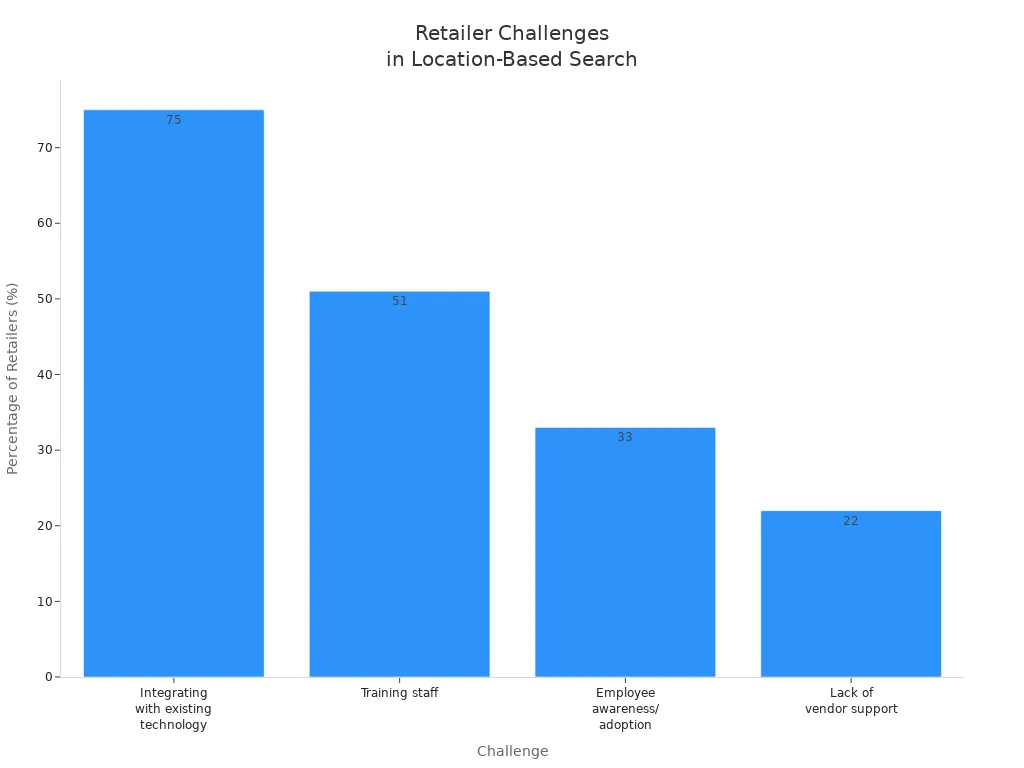Using Location-Based Search for Retail Projects

Location-Based Search gives you an edge in retail. When you use this tool, you can boost sales, reach more customers, and choose store sites with confidence. Just look at the numbers:
Statistic Description | Percentage |
|---|---|
Consumers engaging with a store after local search | 88% |
Offline purchases resulting from local mobile searches | 78% |
Local searches resulting in a purchase | 28% |
You can send real-time offers and alerts to shoppers near your store. This helps you connect with them at the perfect moment. However, you need to be transparent about data collection and follow privacy rules. Always check with data protection experts since laws may vary by location.
Key Takeaways
Location-Based Search boosts sales by connecting with customers at the right moment. Use real-time offers to engage shoppers nearby.
Choosing the right store location is crucial. Analyze foot traffic and local demographics to find the best spot for your business.
Personalize marketing efforts by sending targeted ads based on customer location. This increases the chances of in-store visits and purchases.
Respect customer privacy by being transparent about data collection. Build trust by explaining how location data benefits shoppers.
Stay updated on emerging technologies like geofencing and predictive analytics. These tools enhance customer experience and improve store performance.
Location-Based Search

Definition
You use Location-Based Search to connect with shoppers based on where they are. Retailers rely on this strategy to reach customers in specific places, like a city or a neighborhood. You can set up a search area using a radius or a virtual boundary around your store. This approach lets you send messages, offers, or ads to people who are nearby. When you use Location-Based Search, you make your marketing more personal and effective.
Tip: You can boost your store’s visibility by tailoring promotions to local events or holidays.
How It Works
Location-Based Search uses technology to find and engage customers. You gather data from many sources, such as mobile devices, Wi-Fi, and store sensors. You then combine this data to get a clear picture of your market. Next, you analyze the information to spot trends and patterns. You use maps and charts to visualize the results. Finally, you make smart decisions about marketing and store operations.
Here’s a quick look at the main steps:
Component/Process | Description |
|---|---|
Data Collection | You gather data from different sources to understand your market. |
Data Integration | You combine all the data for a complete view of your retail landscape. |
Data Analysis | You use analytics to find insights in location data. |
Visualization and Reporting | You turn complex data into easy-to-read maps and charts. |
Decision Support | You use the insights to make smart business choices. |
You also use tools like geofencing, indoor navigation, and real-time analytics. Geofencing sets up virtual boundaries to send offers to nearby shoppers. Indoor navigation helps customers find stores and products. Real-time analytics tracks foot traffic and customer behavior.
Use Cases
Location-Based Search helps you in many ways:
You pick the best site for your store by using maps and demographic data.
You offer products that match local tastes, like specialty items for certain communities.
You send targeted ads and discounts to people near your store.
You link online activity with in-store visits to understand your customers better.
You set benchmarks to manage store performance and improve results.
Note: When you use Location-Based Search, you make your retail strategy smarter and more customer-focused.
Benefits

Customer Engagement
You want your customers to feel seen and valued. Location-Based Search helps you do just that. When you know where your shoppers are, you can connect with them in ways that matter. You can send them offers when they walk by your store or even when they enter a certain area. This makes your messages feel personal and timely.
You learn about customer behavior and preferences by tracking their locations.
You can change your store layout or product placement based on what your customers like.
You adapt quickly to what your shoppers need, making their experience better.
Tip: When you use geofencing, you can send special deals to customers as soon as they enter a set area. This often leads to more people coming into your store and making purchases.
Marketing
Marketing gets a big boost from Location-Based Search. You can reach the right people at the right time. Instead of sending the same ad to everyone, you target shoppers who are nearby or who have visited before. This makes your marketing smarter and more effective.
You send promotions that match local events, which makes your offers more appealing.
You reach customers with timely ads, giving you an edge over your competition.
You use your marketing budget wisely by focusing on areas that bring in the most sales.
You build brand awareness in neighborhoods where you want to grow.
Evidence Description | Key Insights |
|---|---|
Retail foot traffic data helps refine merchandising strategies | By understanding customer movement, you can place products where shoppers are most likely to buy them. |
Measurement of in-store promotion effectiveness | Tracking visits to certain displays during sales helps you see what works best. |
Hyperlocal marketing and geofencing | Sending ads to people nearby increases the chance they will visit your store. |
Did you know? Nine out of ten marketers say that location-based marketing leads to more sales. That’s a huge reason to start using these tools.
Site Selection
Choosing the right spot for your store can make or break your business. Location-Based Search gives you the data you need to pick the best place. You don’t have to guess anymore. You can look at maps, traffic patterns, and even what other stores are nearby.
You check foot traffic to see how many people pass by at different times.
You study who lives and shops in the area, so you know if your store will fit in.
You use AI tools to compare locations, looking at things like nearby competitors and customer habits.
You find out if there are points of interest, like schools or parks, that could bring more shoppers.
Note: Geospatial data helps you see if your store will be easy for your target customers to reach. You can even use drive-time maps to check how far people will travel to visit you.
Performance Analysis
Once your store is open, you want to know how it’s doing. Location-Based Search helps you track important numbers. You can see how many people come in, where they come from, and what they do inside your store. This helps you make smart choices to improve your business.
Metric | Description | Impact |
|---|---|---|
Foot traffic | Improves how you run your store, makes customers happier, and boosts sales. | |
Catchment area | Looks at the area where your customers come from. | Helps you plan promotions and decide where to open new stores. |
Customer demographics & behavior | Shows who shops with you and what they like. | Lets you pick the right products and make your marketing more personal. |
Competitor locations | Maps out where your rivals are. | Helps you spot new opportunities and plan your next move. |
You use traffic data to spot busy times and adjust your staff or promotions.
You learn which products attract the most attention, so you can stock up on what sells best.
You see how your store compares to others, helping you set goals and measure success.
Tip: When you use Location-Based Search for performance analysis, you can react fast to changes and keep your store ahead of the game.
Implementation
Technology
You have many tools to help you track where your customers go and how they shop. Some of the most popular technologies include Wi-Fi, RFID, GPS, and beacons. Each one works in a different way, but all help you understand your shoppers better.
Technology | Description | Benefits |
|---|---|---|
Wi-Fi | A network that can detect returning customers and send alerts for promotions. | Increases customer retention through targeted offers. |
RFID | Uses tags to automatically identify and track objects. | Efficient asset tracking without human intervention. |
GPS | Provides real-time location tracking of entities. | Enables precise location surveillance. |
Beacons | Bluetooth devices that send signals to nearby smartphones. | Facilitates personalized marketing and customer engagement. |
You can use Wi-Fi to spot when a customer comes back to your store. RFID tags help you keep track of products and assets without extra work. GPS lets you see where people are in real time. Beacons send special offers to shoppers’ phones when they walk by.
Geofencing is another smart tool. It uses GPS, Wi-Fi, Bluetooth, and RFID together to set up virtual boundaries around your store. When a customer enters this area, you can send them a message or a discount. This makes shopping more fun and helps you boost sales.
Tip: Try combining these technologies for the best results. You can reach more customers and make their experience better.
Data Analysis
You need to make sense of all the data you collect. Data analysis helps you turn numbers into smart decisions. You can look at things like how far your store is from schools or parks, who lives nearby, and how many people walk or drive past your store.
You can check location details, like distance to popular places and local demographics.
You can compare these details with your sales numbers to spot patterns.
You can use math tools like correlation and regression to find out what works best.
Here’s how you can use data analysis to make your store stronger:
Use geospatial data to learn how customers behave. This helps you pick the best spot for your store.
Study foot traffic patterns. You can plan your staff schedules and make sure you have enough help during busy times.
Forecast retail traffic. You can use this information to plan for the future and keep your store successful.
Retailers often map out where competitors are and look at foot traffic trends. This helps you find places where your store can do well. You can also use drive-time maps to see how far customers will travel to visit you.
Data Source | Purpose |
|---|---|
Demographics and Psychographics | Understand the local population's characteristics and purchasing motivations. |
Consumer Spending Patterns | Analyze local spending habits to forecast market share and revenue. |
Foot and Vehicular Traffic Data | Assess visitor patterns for better site accessibility and visibility. |
Competitor Locations | Identify market gaps by mapping competitor presence. |
First-Party Data Integration | Combine internal sales data with external datasets for accurate predictions. |
Predictive Modeling | Generate data-backed revenue projections for informed decision-making. |
Market Planning Tools | Visualize expansion strategies and assess impacts of new stores. |
Whitespace Analysis | Discover untapped markets with high demand and low competition. |
Customizable Dashboards | Focus on key metrics with real-time insights without manual calculations. |
You can use dashboards to see important numbers fast. This helps you make quick choices and stay ahead of the competition.
Note: When you use data analysis, you can find new customers, plan better, and grow your business.
Best Practices
You want your Location-Based Search to work well and make shopping easy for your customers. Here are some best practices you can follow:
Help customers find products with in-store navigation.
Use lead capture tools to collect customer info right from your store locator.
Set up dashboards to track how customers interact with your store and what they search for.
Here are some simple steps to make your store locator better:
Show only 5-10 locations at a time so customers don’t feel overwhelmed.
Use geolocation to display stores near your customers automatically.
Link to navigation apps so customers can get directions easily.
Make sure your store locator works well on mobile devices.
Add clickable phone numbers so customers can call your store quickly.
Give accurate details about each store, like hours and services.
Let customers search and filter for stores with special products.
Keep your branding strong so your store locator matches your style.
Studies show that 18% of people who search for a store on their phone will visit that store the same day. This means your store locator and search tools need to be easy to use and up-to-date.
You might face some challenges when you start using these new tools. Many retailers say it’s hard to connect new technology with old systems. Training your team and getting everyone excited about the changes can help. Celebrate small wins to keep your team motivated.

Tip: Ask your retail solution provider for advice and customer stories. This can help you learn what works and avoid common mistakes.
Privacy and Compliance
Privacy Concerns
You want your customers to trust you. When you use location-based search, privacy becomes a big deal. Many people worry about how companies handle their personal information. In fact, a survey found that 81% of people feel companies are not clear about what they do with personal data. Groups like the ACLU warn about risks such as surveillance and misuse of location data.
Customers fear that you might track them without their knowledge.
Mixing location data with other details can create ethical problems.
People want to know how you use their information and if you share it.
Tip: Always explain why you collect location data and how it helps your customers. This builds trust and keeps your brand strong.
Opt-In Strategies
Getting customers to say “yes” to location tracking is not easy. You need to show them the benefits and respect their privacy. Here are some ways to help customers feel safe and willing to opt in:
Offer clear value, like special discounts or personalized shopping experiences.
Build trust by showing you care about privacy.
Use simple and honest language in your opt-in requests.
Address privacy concerns directly and explain how you protect their data.
Ask for consent at the right moment, such as during sign-up or when offering a reward.
Be open about how you use location data and what customers get in return.
Watch for signs of trust issues, like high opt-out rates, and adjust your approach.
Test your opt-in strategies before using them everywhere.
Focus on helpfulness, not surveillance, to avoid making customers uncomfortable.
Note: When you match technology to customer needs, you make location-based services feel useful, not creepy.
Legal Requirements
You must follow strict rules when you collect and use location data. Different countries have different laws, so you need to stay updated. Here’s a quick look at some key regulations:
Regulation | Key Requirement |
|---|---|
GDPR | Get user consent before collecting data; let users access, delete, or change their data. |
CCPA | Tell customers about data collection; let them opt out and request deletion. |
PCI DSS | Keep payment card data safe to prevent fraud. |
PIPL | Follow strict data storage and security rules in China. |
DPDP | Use strong data protection in India. |
Always get clear consent before collecting location data.
Tell customers why and how you collect their information.
Give people the choice to opt out of sharing their location.
Let customers see, change, or delete their data if they want.
Remember: Following privacy laws protects your business and keeps your customers happy.
Trends
Emerging Tech
You see new technology changing how you use location-based search in retail. These tools help you connect with shoppers in ways that were not possible before. Here’s a quick look at some of the most exciting tech shaping the future:
Technology | Description |
|---|---|
IoT Integration | Devices collect and share real-time location data, making shopping smoother and smarter. |
Augmented Reality (AR) | Digital info appears over the real world, helping you find products or see how they look. |
Predictive Analytics | Data helps you guess what shoppers want and when they want it. |
Geofencing | Virtual boundaries let you send offers to people as they enter certain areas. |
Indoor Positioning Systems | Wi-Fi and Bluetooth help you find your way inside big stores or malls. |
Micro-Moments Marketing | You get quick, helpful info right when you need it, based on where you are. |
You might notice stores using AR to let you “try on” products or see how furniture fits in your home. IoT devices in smart cities help with traffic and safety, but they also make shopping more personal. Geofencing lets you get special deals as soon as you walk near a store. Indoor positioning helps you find your favorite shop in a busy mall. These tools make shopping easier and more fun.
Future Retail
You can expect location-based search to play a bigger role in how stores work. Retailers now use location intelligence to study where shoppers go and what they like. This helps them pick the best spots for new stores and plan better sales. AI helps stores find the best locations before anyone else. Physical stores are not just for shopping—they help brands meet new customers. If a store closes, online sales can drop too, showing how connected online and offline shopping have become.
You will see more shopping on phones. By 2025, e-commerce could make up 21% of all retail sales. People want shopping to feel personal, so stores use location-based tools to give you offers that fit your needs. With 5G, AR, and machine learning, you get cool ads and easy navigation in stores. Retailers use these smart tools to make your shopping experience better every year.
Location-based search can change how you run your retail projects. You boost your store’s visibility, shape your brand, and make shopping easier for your customers.
Key Takeaway | Explanation |
|---|---|
Enhances Visibility | A well-chosen location attracts more target customers. |
Influences Brand Perception | Prime locations show quality and reliability. |
Fosters Customer Convenience | Easy access keeps shoppers coming back. |
To get started, follow these steps:
Protect privacy by anonymizing and encrypting data.
Stay open about how you collect and use information.
Follow privacy laws to build trust.
You can use data and tech to send personalized offers, share accurate store info, and track how each branch performs. Keep an eye on new tools like micro-geofencing and predictive analytics. If you stay flexible and keep learning, you will always be ready for what’s next in retail. 🚀
FAQ
What is location-based search in retail?
Location-based search lets you find stores, products, or deals near you. Retailers use your location to show you the closest options. You get more relevant results and offers that match where you are.
How do retailers collect location data?
Retailers use Wi-Fi, GPS, RFID, and beacons to track your location. Your phone or device shares this data when you opt in. You control what you share by adjusting your privacy settings.
Is my personal information safe with location-based search?
You stay safe when retailers follow privacy laws and use secure systems. Always check privacy policies before sharing your location. Look for clear opt-in choices and data protection statements.
Can I turn off location tracking?
Yes, you can! Just go to your device settings and switch off location services. You can also opt out on store apps. If you have questions, ask the retailer for help.
See Also
Unveiling Sensi Retail: A Cannabis Dispensary for All
Finding Top Corner Stores Just Steps Away From You
Creative Vending Machine Sites: Discovering New Hotspots
